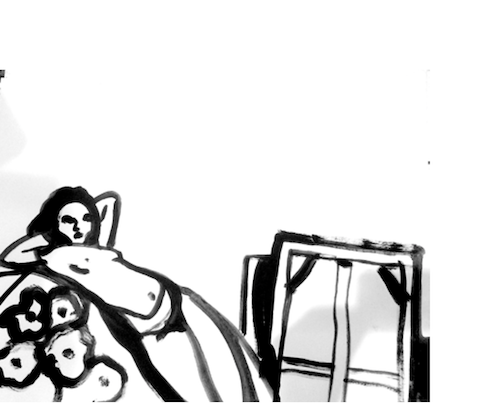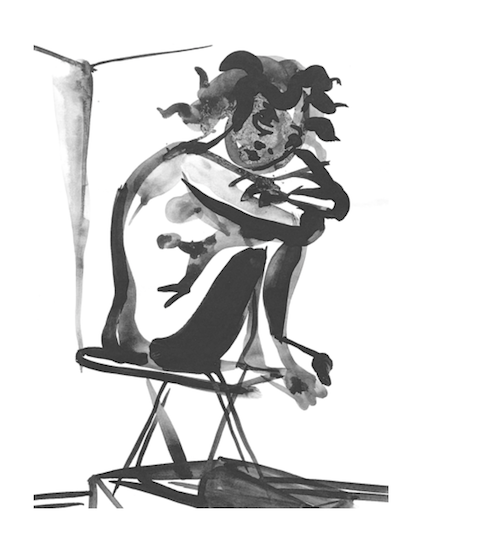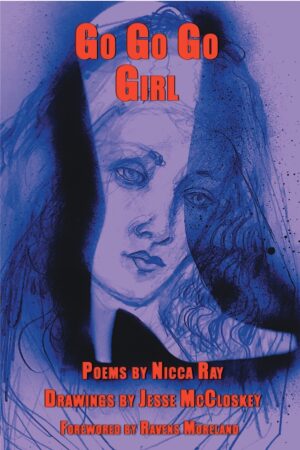Nicca Ray on “Go Go Go Girl”
Randee Silv & Nicca Ray
June 2024
Randee Silv: Your new collection of memoir poems, Go Go Go Girl, was just released by Poison Fang Books. One can’t help but notice this strong, dynamic connection that’s going on between your words and the artwork by Jesse McCloskey that accompanies each poem. They seem to reveal almost hidden layers that words aren’t able to express. There’s this feeling of unspoken dialogue, a triggering. I’m curious. Which provokes which? What is the relationship between the poems and the drawings for you?
Nicca Ray: I wrote some of the poems, Her Eyes That Cat Her Pupils Splat and Head Up Bored Stiff, for example, to his drawings. I let the images evoke feelings and out of those feelings came the poem. The woman lying on her back in Head Up reminded me of times I have laid on my back detached from the person I was lying with and/or disassociating from myself. Jesse has seen me in this position many times over the course of our relationship, so I felt very close to this drawing as if Jesse was telling me it was okay to lie Head Up Bored Stiff. Jesse’s drawings tap into the darker parts of me even when they aren’t necessarily drawings of me. In the drawing for Her Eyes That Cat Her Pupils Splat I saw myself when I don’t want to feel. Turning to stone is a defense mechanism against memories from trauma. I think that Jesse puts himself in these drawings of women, too. He’s able to express his emotional side – his darkness if you will. Perhaps he’s more comfortable portraying his own raw emotions in the female gender because femininity allows for vulnerability in a way masculinity doesn’t lend itself to.
In poems such as Daydreaming Darkness on the Chez Lounge and Remembering Beauty, I wrote the poem first, then Jesse chose drawings to go with them. He’s prolific and we’re symbiotic, so when it came time for him to choose a drawing for the poems, he had no trouble. Sometimes I think we are different parts of the same self.
Jesse speaks in images to describe his inner landscape while I use poetry to describe mine. We ride in tandem. It’s a visceral knowledge, understanding of the other, that we’ve always had.
DAYDREAMING DARKNESS ON THE CHEZ LOUNGE
I’m going to go to the beach today. Put my chez lounge in the sand. Catch the sun. Turn it around. Facing the other side of land. I’m going to superimpose myself onto the blue crashing surf. Ride the waves ‘til the water turns black. Close my eyes. Seaweed hair. Wrap in turban. Catch the sun with kite string blowing my mind. Turn it around. Face it. Sunlight imposition on darkest thought blisters. Burns malaise upside down. Turn around the chez lounge face it. The midnight raging sea back to me. Turn it around. Face it. The thought-loop-loop-thought combustion.
RS: Yes, I can see that you both delve into whatever might surface no matter what. Boundaries are dismissed, and there’s a reaching beyond any interference. What seems clear in your poems is that there’s a revisiting, a reflection of what has already been. But there’s also a forward motion acting like a propeller. Poetry can take you anywhere. As a writer, what gravitates you toward this spectrum?
NR: Poetry allows for ambiguity. Going into the past where there is trauma can be a wordless terrain. I want to put words to those memories. Poetry gives me permission to tell with sounds and rhythms. The juxtaposition of images also gives meaning to a situation that when looking back on it makes no sense. Makes no sense in that there’s no justifiable reason why it happened. If I can put one and one together, I can find reason or a way out. Poetry is freedom.
RS: Very strongly said. Poetry can definitely stir the possibilities of exits. In the last lines of “Talking in Sleep”, there’s an opening, a reshaping. It’s also very present in the poem, “Clean Slate”.
with every turn a word
a word commanding
a cease
with every corner lit
freedom comes to light
a breath
CLEAN SLATE
I pack suitcases
Fill them with all my yesterdays
Check them into Flight 101 to Los Angeles
I won’t be joining them
I’m sending them back to where they belong
They can spin forever
On an unsuspecting baggage claim
Owner unidentified
Unknown
Your gathering of words, your visual imagery throughout Go Go Go Girl, creates a deep arena where one can either connect, disconnect, or run far from. What would you like us to taste?
NR: I’d like my readers to go with me to places they might be too afraid to go to alone. I want them to feel safe with my lead. We can discover, confront, disassociate, remember, together. For readers whose life experiences have been different I would hope they’d join me in gaining a better understanding of what it is to be human. I want them to taste all the different colors – to run from but be unable to run away and in the end find connection.
RS: What it is to be human. Finding common ground. Powerful gifts to give others. Just like what you wrote in the intro “I don’t shy away from the dark. I look for the beauty in the darkness.” Something that radiates from every page. You’ve titled this collection Go Go Go Girl. Who exactly is she? And how did you land on this for the title?
GO GO GO GIRL
she’s a sunset strip billboard glitter go
to the knee high
top of the hill
terrace view terracotta go go go girl
in pixel cool
NR: I grew up a 15-minute car ride from the Sunset Strip. The billboards plastering the boulevard in the 1970s promised a glamorous life – a fantasy world I wanted to be a part of. I don’t know exactly how old I was when I first learned of a Go-Go dancer. Maybe it was Goldie Hawn on the comedy show Laugh In or the music show The Reel Don Steele, but I was still in elementary school. I thought being a Go-Go dancer would be really cool. My mother had been a dancer in the MGM musicals of the 1950s. She was a trained ballerina and would teach my older sister and I dance steps I could never follow. But in the privacy of my own bedroom, I could Go-Go all night long.
Go Go Go has a force, a push, a feeling of triumph I want my girl to have. I have experienced things that should have kept me down, but I refuse to be waylaid by the past.
Who is Go Go Go Girl? If I define her, she may contradict the definition. I think we’ve got to go with the movement of the Go Go Go and sit still in the moments between each Go to discover who the girl is.
RS: I can totally relate with what you’re saying. I think we’ve all been lured some way or the other by those billboards. Advertisements. Movies. Fantasies. Glamor. But it’s in those pauses, when we reflect, regroup, that we touch the unexpected, that spark. Reading your poems, one can be energized by their strength, determination. Their openness. Their fearlessness.
I WISH I WAS HER
Eloquence
In pose
In eye
The slight wave in her hair The kind of woman
I wish to be
No sign of unease
She possesses a still comfort No shame of
Body
or
Mind
BACKFLIP BALLERINA
she rose from ashes
heart shaped bosom mermaid feet
tied to the belly of the beast
her tousled hair
brushes against
clawed finger
she is risen in his image
his clamp on her
can’t be her end
her torso
bending, slipping, a backflipping
ballerina
firefly light
meteor
showering day onto night
RS: Is there anything you feel like you haven’t touched upon in your writing? Something that maybe is still brewing? Something that hasn’t shown itself yet?
NR: Absolutely. I feel I have so much more to say. There are portions of my life I haven’t yet explored in poetry. The not-so traumatic. I often think of beauty and what it means to be beautiful. I think about buoyancy, romance, love, lust, joy and if I can venture into those territories without losing depth, without being cheesy. I feel as if I’m at a threshold; that I’m going to enter a place I’ve never been before. A state of mind not yet known. I approach this evolution of self with wonder. I’m looking forward to what will be revealed and writing about it.
RS: There are pools of occurrences, of crossroads, of observations that we have to build upon. But yes, how does one approach them without sounding “corny”, “boring”, or “self-indulgent”? It’s easy to just toss words out there, but giving them a significant, notable voice, that’s a question we have to constantly ask ourselves. And then there’s always the issue of how much do we want to expose? How does one construct a wonderment without evading the very real tensions of vulnerability? How does one voyage into this process and produce work that is resilient?
NR: Capturing moments and putting them side by side. Each moment is different. One thought might take over and throw a curve ball into a particular moment which creates a new moment. Avoiding emotional manipulation. Staying with truth. Reflecting on self but looking at my place in the world with the realization I’m just one part of a bigger whole. Take away self-importance and posturing. Being an open book without losing the mystery. Knowing is fluid. Yesterday’s answer isn’t set in stone. There are facts, yes, but within those facts exists a journey and within that journey is a fluidity, an impermanence that makes room for wonderment. Not knowing is a vulnerable state. There’s the tension between needing to know and not knowing. Not knowing requires trust, and it isn’t always so easy to trust. I can know where the starting point is and have an idea about where the poem will end, but the ending is a mystery until I reach it. I must follow where the moments lead and listen to where they’re taking me. The end will tell me when it’s arrived. Each end brings about a deeper understanding of self and what it is to be a human being. With each end, though, there is a new beginning. Perhaps that’s where the resiliency comes in.
RS: For sure. We’re constantly immersed in stops, starts and the passion of being present. I know that you and Kathleen Florence have done video projects together with your poems and Jesse’s artwork, that you’ve been involved in acting, in writing plays, in directing short films, have published a handful of books, and have some upcoming projects. I’m sure you’ve done plenty of poetry readings, but I just wanted to ask if you’ve ever collaborated with musicians in live shows or considered anything in that direction.
NR: I’m a huge fan of Kathleen’s. I hope to work on more video collaborations with her. I’m excited about the projects happening. There’s Go Go Go Girl, which I’m super thrilled about, a memoir, Love and Cigarettes (Punk Hostage Press), and a play, The Cry of the Butterfly, to be done in 2025 in NYC. I have done a few poetry readings, that’s true. And yes, I have collaborated with Barry Reynolds (best known for his work with Marianne Faithful). We’ve done several performances in NYC. I hope to do more.
A showcase of video poems written and performed by Nicca Ray from Go Go Go Girl, with drawings by Jesse McCloskey and directed by Kathleen Florence.
Go Go Go Girl
poems by Nicca Ray
Drawings by Jesse McCloskey
Poison Fang Books, 2024
You can email Nicca Ray and get a signed copy of Go Go Go Girl for $20 which includes shipping and a one of a kind bookmark made by Nicca.
Contact Nicca at niccaray[at]gmail.com



